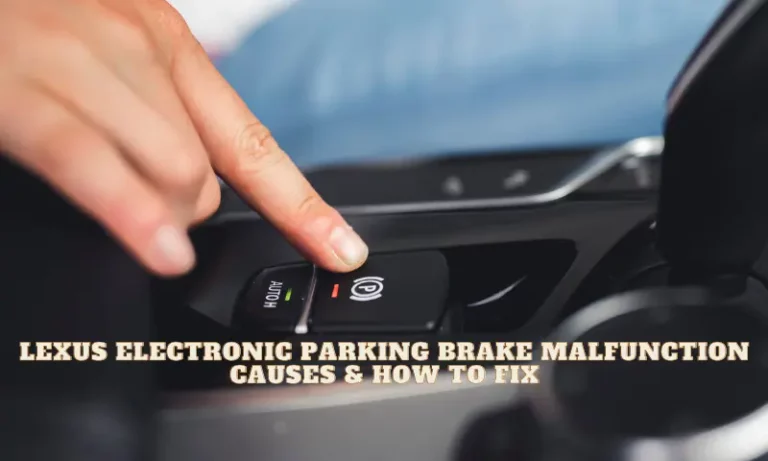So, you turn on your car, and the Lexus Electronic Parking Brake Malfunction light illuminates your instrument cluster. Or you push the auto brake button and see an error message that says, “Parking Brake Unavailable.” Although you can still drive the vehicle, the light doesn’t disappear, and that can cause a headache.
If your vehicle is less than 100k miles old, the issue is probably not a result of natural wear and tear. So, what could have happened? Is there a way to fix it yourself and avoid a trip to the dealer? Let’s find out below.
What Is the Electronic Parking Brake on Lexus?
The Electronic Parking Brake (EPB) on Lexus is an electronically-controlled braking system built into the onboard computer. It offers a safer and more convenient braking experience in different situations. When you activate the EPB, the system transmits tensile power to ensure that your vehicle doesn’t move unintentionally.
You operate the EPB through a push-button (automatic brake button). Upon pressing the button, the computer sends an electric signal to a mechanism (an actuator) that makes the brake pads close and stop the vehicle. Conversely, when you deactivate the system, the brake pads release. A warning light will pop up in your dash to alert you when a malfunction happens in the EPB.
What Causes the Lexus Electronic Parking Brake Malfunction?
There are several causes of the Lexus Electronic Parking Brake malfunction. They include lousy components, low voltage problems, and other ordinary electrical faults, such as a blown fuse or broken wires. Sometimes the problem could be due to a worn-out component.
Let’s discuss this at length:
Possible Cause #1: Lousy Electronic Parking Brake Components
The components of the electric parking brake can trigger the problem if they are in poor condition. For example, worn-out brake pads will likely affect the proper functioning of the vehicle’s braking system. The pads won’t exert enough pressure to stop the car.
Electronic parking brake malfunction can also occur if the brake fluid leaks. That’s possibly due to a worn seal in the caliper, wheel cylinder, or master cylinder. Moreover, a defective ignition coil could trigger the problem.
How to Fix: Examine all the braking system’s components and ensure they work well. Ensure the brake pads are functioning correctly. Check and make sure that there are no brake fluid leaks. If you find any, tow your vehicle to a reliable auto shop for servicing. Lastly, make sure all the cables that operate the electric brake are in the proper condition. You may require a multimeter for this exercise.
Possible Cause #2: Low Voltage Issue
The automatic braking system requires a sufficient amount of voltage to function correctly. The Powertrain Control Module (PCM or vehicle’s computer) may return an error code if it gets less voltage than necessary. A low voltage problem could be a result of the poor battery condition.
Sometimes the battery might supply enough power to crank up the engine and drive the car. Nevertheless, it may be too weak to support all the electrical systems in your vehicle, including the electronic parking brake. Fortunately, the solution is easy.
How to Resolve: Find a multimeter and check the battery voltage. A healthy battery should produce a voltage of between 12.4 and 12.7 volts. If the battery generates below 12.4 volts, you would be better off replacing it with a new one. Hopefully, it’s that simple!
Possible Cause #3: Other Electrical Problems
A problem can happen on the EPB if an electrical issue occurs. Switches or wires between the electronic control module and the actuator can open. They can as well short-circuit, rust, break, or develop high resistance. It could also be an open fuse that is cutting off the power supply to the electronic parking brake.
Faults in the wiring harness can lead to similar issues. These are common issues that can happen with continued use. When any of them occurs, it will likely register a trouble code on the onboard computer. In return, you will see a “Service parking brake” message on your dash.
How to Fix: Check all the electrical connections and ensure no exposed or cut wires, rusting, or corrosion on switches. Fix any troubled wire you find to ensure a smooth flow of electric current. Also, clean any rusting and degeneration on the fuse and replace it if necessary. You may need to visit the dealer as sometimes the electrical problem is something you need help figuring out.
Possible Cause #4. Faulty Parking Brake
If it’s not a low voltage problem or an electrical fault, then it’s likely that the component itself is defective. Unfortunately, this is always one of the things that most people, including dealers, hardly suspect. That’s because it’s uncommon for the component to break down.
When you take the car to your dealership, an electrical issue is probably the first thing that comes to mind. Sometimes they may blame the lowering of springs and another batch of triggers. They will probably rule all of them out after a couple or more attempts to solve the problem.
How to Fix: Reprogram or replace the Electronic Parking Brake. Again, you may need your dealer’s or experienced mechanic’s help. But if you’re mechanically savvy, order the part and install it yourself at home!
Note: We recommend taking your vehicle to the dealer if it’s still under warranty. Avoid the Do-It-Yourself approach, as it can interfere with the warranty. Only choose to DIY if you’re sure it’s something you can handle.
Conclusion
The Lexus Electronic Parking Brake malfunction can happen anytime, even if your vehicle is less than 100k miles old. The issue will probably not prevent the car from moving. However, seeing the warning light on isn’t something you want to put up with.
Besides, the EPB light illuminating your dash means something is wrong with the system. It would help if you fixed it immediately for your convenience and safety. Our article has helped you determine the cause and solution to the mechanical mishap.












